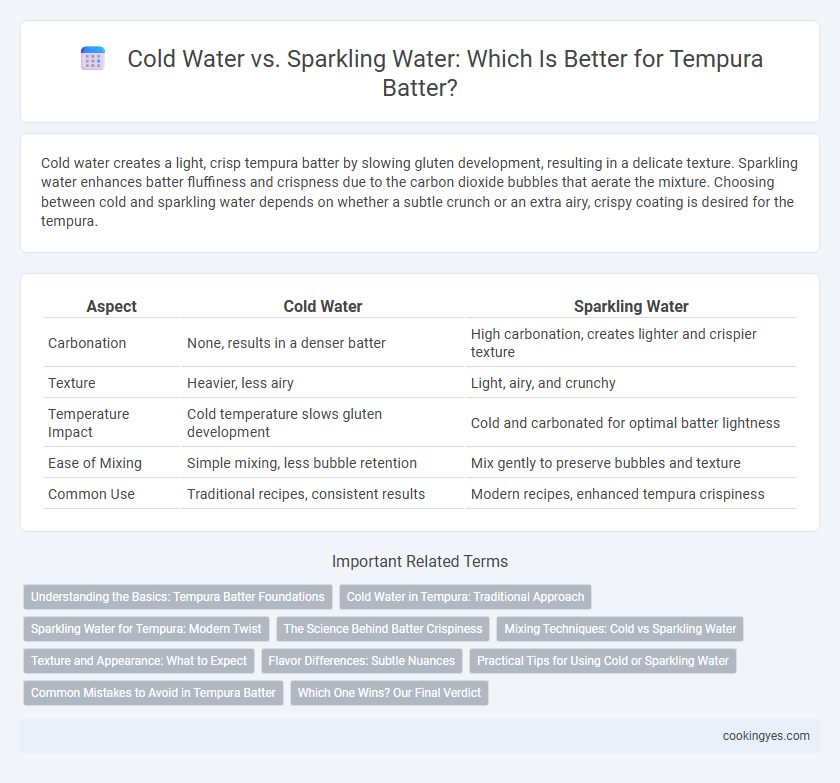Cold water creates a light, crisp tempura batter by slowing gluten development, resulting in a delicate texture. Sparkling water enhances batter fluffiness and crispness due to the carbon dioxide bubbles that aerate the mixture. Choosing between cold and sparkling water depends on whether a subtle crunch or an extra airy, crispy coating is desired for the tempura.
Table of Comparison
| Aspect | Cold Water | Sparkling Water |
|---|---|---|
| Carbonation | None, results in a denser batter | High carbonation, creates lighter and crispier texture |
| Texture | Heavier, less airy | Light, airy, and crunchy |
| Temperature Impact | Cold temperature slows gluten development | Cold and carbonated for optimal batter lightness |
| Ease of Mixing | Simple mixing, less bubble retention | Mix gently to preserve bubbles and texture |
| Common Use | Traditional recipes, consistent results | Modern recipes, enhanced tempura crispiness |
Understanding the Basics: Tempura Batter Foundations
Cold water is essential for creating a light and crispy tempura batter by slowing gluten development in the flour. Sparkling water introduces carbonation, which can enhance batter texture by adding extra airiness and crispness. Both options maintain low temperatures critical for preventing oil absorption and achieving the signature delicate tempura crust.
Cold Water in Tempura: Traditional Approach
Cold water is the traditional choice for tempura batter, as its low temperature helps inhibit gluten formation, resulting in a light and crispy texture. Using ice-cold water maintains a delicate batter consistency that clings evenly to ingredients without becoming heavy or doughy. This method preserves the authentic tempura crispiness that highlights the balance between tender interior and crisp exterior.
Sparkling Water for Tempura: Modern Twist
Sparkling water enhances tempura batter by introducing fine bubbles that create a lighter, crispier texture compared to cold water. The carbonation helps to aerate the batter, preventing gluten formation and resulting in a delicate, crunchy finish. Chefs increasingly favor sparkling water to achieve a modern twist on traditional tempura, offering an elevated eating experience.
The Science Behind Batter Crispiness
Cold water slows gluten formation in tempura batter, resulting in a lighter, crispier texture by reducing protein development. Sparkling water introduces carbon dioxide bubbles that create tiny air pockets during frying, enhancing batter aeration and crispiness. The combination of low temperature and carbonation optimizes the batter's molecular structure, producing a delicate and crunchy coating.
Mixing Techniques: Cold vs Sparkling Water
Cold water preserves the tempura batter's low temperature, preventing gluten formation and resulting in a lighter, crispier texture. Sparkling water introduces carbonation that creates tiny bubbles, enhancing batter aeration and producing a delicate, flaky crust. The mixing technique involves minimal stirring to maintain temperature and bubble integrity, crucial for achieving the signature tempura crispness.
Texture and Appearance: What to Expect
Using cold water in tempura batter enhances a light, crispy texture by slowing gluten formation, resulting in a smooth, golden appearance. Sparkling water introduces carbon dioxide bubbles that create a lighter, airier crust with more visible, delicate bubbles on the tempura's surface. Both options improve texture and appearance but sparkling water tends to yield a more pronounced crispiness and a slightly puffier, visually dynamic finish.
Flavor Differences: Subtle Nuances
Cold water in tempura batter creates a delicate, crisp texture with a mild flavor allowing the natural taste of the ingredients to shine. Sparkling water introduces tiny bubbles that enhance lightness and add a subtle effervescence, creating a slightly more complex flavor profile. The carbonation in sparkling water can also contribute to a fresher, airier bite, making the tempura feel less dense compared to batters made with cold still water.
Practical Tips for Using Cold or Sparkling Water
Using ice-cold water in tempura batter ensures a lighter, crispier texture by slowing gluten formation, while sparkling water introduces bubbles that create additional air pockets for enhanced crunch. Practical tips include keeping water chilled and mixing batter gently to maintain a lumpy consistency, avoiding overmixing to prevent toughness. For sparkling water, use fresh, cold soda and incorporate it last to preserve carbonation and maximize batter lightness.
Common Mistakes to Avoid in Tempura Batter
Using cold water instead of sparkling water in tempura batter helps maintain a light, crispy texture by preventing over-activation of gluten, a common mistake that leads to dense coating. Avoid warm or room temperature water as it can cause the batter to become too thick and heavy, resulting in greasy, soggy tempura. Another frequent error is overmixing the batter, which develops gluten and reduces crispiness, so combine ingredients gently using cold or sparkling water for optimal results.
Which One Wins? Our Final Verdict
Cold water maintains a consistent temperature that prevents the batter from activating gluten, resulting in a light, crispy tempura coating. Sparkling water introduces carbonation that creates air pockets and a lighter texture but may lead to uneven batter adherence. Our final verdict favors cold water for its reliable crispiness and traditional authenticity in tempura preparation.
Cold Water vs Sparkling Water for Tempura Batter Infographic

 cookingyes.com
cookingyes.com